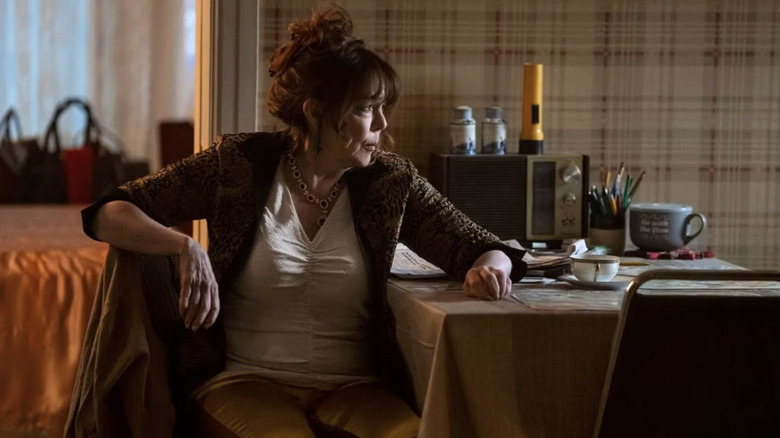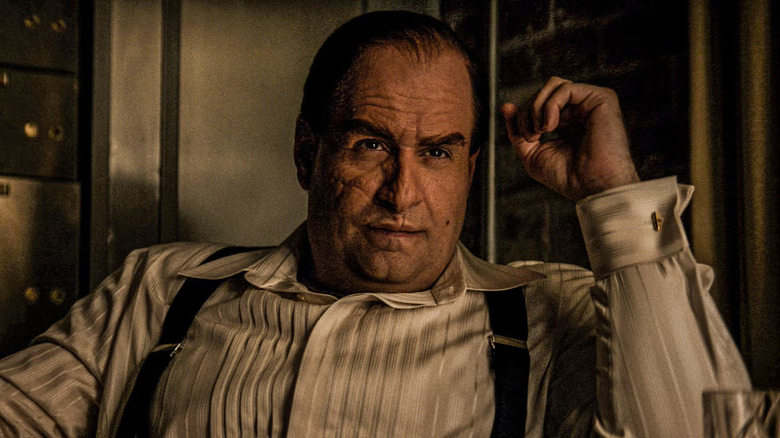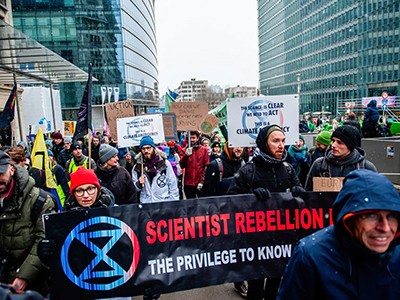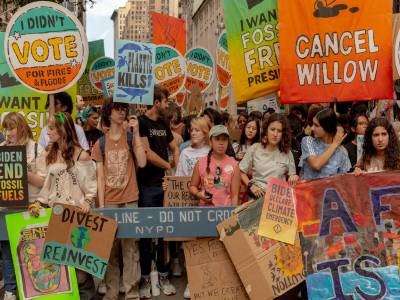[ad_1]
Este artículo contiene Spoilers leves Para el episodio 6 de “Penguin”.
En esencia, el arte y el entretenimiento son exploraciones y debates sobre la condición humana. Esto va más allá de ser simplemente educativo o simplemente una distracción necesaria (aunque ciertamente también puede funcionar en ambos sentidos); El arte permite y amplía la empatía y una comprensión más profunda del mundo y de quienes viven en él. Para muchos de nosotros, el arte nos dice que no estamos solos y que los eventos, pensamientos y emociones que experimentamos, ya sean felices o trágicos, son una experiencia compartida. El concepto de “crear conciencia” suena trillado y casi inútil sobre el papel, pero a través del arte bien hecho, puede ser tremendamente efectivo.
Por eso estaba tan emocionado de ver el episodio 6 de Max. “Pingüino” Porque incluye una escena que no sólo ayuda a profundizar los personajes de Oz Cobb (Colin Farrell) y su madre Frances (Deidre O'Connell), sino que también introduce el tema de una enfermedad real con la que mi familia y yo luchamos. He estado lidiando con esto durante los últimos años desde el diagnóstico de mi padre. En la escena, Oz le cuenta a su amigo/compañero/estudiante Víctor (Renzi Vélez) por qué se dedica personalmente a cuidar a su madre. Resulta que no solo es anciana, sino que actualmente sufre una afección conocida como demencia con cuerpos de Lewy. Esta enfermedad es una rama de la enfermedad de Parkinson, hasta el punto de que a menudo una se diagnostica erróneamente en relación con la otra, y aunque no es una enfermedad nueva, no se conoce ni se habla mucho de ella.
Por lo tanto, su aparición en “El Pingüino” no es sólo un escrito ingenioso, que agrega más realismo a una serie basada en el universo del cómic de “Batman”, sino que también es algo que me ayuda a mí y a otras personas que tienen personas a quienes aman. El amor que padece esta condición se siente visto, escuchado y comprendido. Como cualquier enfermedad, una mayor discusión sobre ella conduce a un mejor diagnóstico, un mejor tratamiento y una mejor comprensión.
Cómo “El Pingüino” utiliza la demencia con cuerpos de Lewy en un drama
Las enfermedades y los problemas médicos se han utilizado como recursos dramáticos desde los albores del drama mismo, no sólo con fines identificables o como una forma de explicar la ausencia de un personaje, sino debido a los efectos secundarios y las repercusiones que ciertas condiciones pueden tener. Algunas enfermedades son de naturaleza más dramática: no muchas películas o programas de televisión han explotado las enfermedades que he tenido en mi vida hasta ahora (a saber, la colitis ulcerosa, una afección hermana de la enfermedad de Crohn y la colangitis esclerosante primaria (también conocida como CEP). una condición en el hígado llevó a un trasplante), pero podrías tirar una piedra y recibir un episodio de una película o serie que incluya un personaje con cáncer o la enfermedad de Alzheimer.
La relación entre la demencia con cuerpos de Lewy y la enfermedad de Alzheimer permite a los narradores aprovechar el extraño valle que ambas enfermedades presentan a través de los síntomas; Para el paciente, el terror creciente de no poder reconocer todo, desde su entorno hasta cómo realizar tareas simples, y para el cuidador, la dificultad de tener que ayudar constantemente a un adulto a reaprender a funcionar.
“Penguin” también aprovecha la capacidad de Lewy para causar confusión e incluso alucinaciones en una persona con la enfermedad. Como describe la Clínica MayoLa demencia con cuerpos de Lewy implica depósitos de proteínas llamados cuerpos de Lewy que se desarrollan dentro de las células nerviosas del cerebro, un proceso que conduce al deterioro del pensamiento, la memoria y el movimiento. Debido a cómo la enfermedad ataca las funciones cognitivas, también puede provocar alucinaciones, como hacer creer a la persona que actualmente vive en una época completamente diferente de su vida. En el caso de Frances, ha estado al tanto de algunos tratos turbios durante su vida en Gotham, tanto cosas que se hizo a sí misma como comentarios que hizo sobre su hijo, lo que puede llevarla a descubrir sin darse cuenta algunos secretos que Oz no quiere revelar.
Además, Oz y Francis tienen una relación polémica además del caso de este último, con Frances presionando constantemente a Oz para que sea más contundente y cruel, algo de lo que puede salirse con la suya dada la fingida devoción de Oz hacia ella. A diferencia de la mayoría de las enfermedades, que tienden a deteriorarse, la demencia con cuerpos de Lewy puede ser un comodín, ya que una persona no pierde nada de su inteligencia, solo su capacidad para procesar el contexto y recordar. En otras palabras, sólo porque Frances tenga la enfermedad no significa que no pueda representar una amenaza, ni para los secretos mejor guardados de su hijo ni para sus enemigos.
La película “Penguin” describe con precisión la confusión que resulta de esta situación.
Parte del equilibrio entre el realismo en la ficción y la narración es que la historia es lo primero. Si bien es apropiado y necesario que las personas detrás del cine y la televisión investiguen e intenten abordar con precisión los problemas de la vida real, siempre será necesario distorsionar la verdad para lograr el máximo efecto dramático. En otras palabras, en última instancia se trata del espíritu de algo, no de la letra.
Lo que “El Pingüino” hace tan admirablemente es retratar con precisión la frustración que uno siente al tratar de cuidar a un miembro de la familia con síndrome de Lewy. En el episodio 6, titulado “Cumbre de Oro”, escrito por Nick Towne y dirigido por Kevin Bray, Oz le expresa esta frustración a Vic, señalando que no es sólo tener que lidiar con la condición de Francis lo que hace que la situación sea difícil, sino también cómo los médicos varias veces diagnosticó erróneamente a su madre, afirmando que primero tenía la enfermedad de Alzheimer, luego la enfermedad de Parkinson y luego la enfermedad de Lewy. Esta serie de eventos refleja directamente mi propia experiencia con el diagnóstico de mi padre, ya que ya ha sido diagnosticado y rediagnosticado varias veces. Es importante tener en cuenta que, hasta el momento, no existe ningún tratamiento ni medicamento que ralentice o revierta la afección, solo cosas que pueden ayudar a tratar o reducir los síntomas. Como tal, vivir con una enfermedad es un proceso continuo, que tiende a resultar en no saber exactamente qué enfermedad estás enfrentando.
“El Pingüino” tiene un realismo que hace que la serie sea más fuerte en su existencia
Por eso es alentador ver a Lewy mencionado en “Penguin”, porque proporciona cierto consuelo y comprensión a aquellos de nosotros que ya estamos familiarizados con la enfermedad. Es una elección sorprendentemente sobria para una adaptación en serie de The Batman de 2022, que introdujo el concepto de una droga recreativa ficticia conocida como Drops, una sustancia que todavía desempeña un papel en The Penguin. Si bien los elementos de fantasía pueden ser tan poderosos como los elementos de la vida real, las gotas siguieron siendo muy ambiguas en la película y la serie; Obviamente son adictivos y en gran medida ilegales, proporcionando a los usuarios una especie de subidón, pero no hemos visto mucho en términos de cómo se siente usarlos versus lo que puede conducir a la adicción a ellos. La droga es mucho más fuerte, como hemos explicado sus orígenes y efectos. Del mismo modo, confirmar el caso de Louise como el de Frances hace que su personaje, sus luchas y su relación con Oz sean más sólidos (y más distintos de dinámicas similares entre personajes similares en otros medios). Como en “Los Soprano”).
En última instancia, la serie que menciona la enfermedad de Lewy es algo completamente positivo, ya que arroja luz sobre una condición que todavía parece estar en la oscuridad, tanto para las personas que desconocen su existencia como para quienes la padecen de primera mano. Como dijo O'Connell en una entrevista reciente en la Comic Con de Nueva York,Vía GamesRadar), también tiene una relación personal con la enfermedad, lo que hace que su trabajo en el programa sea más informado:
“Sé más sobre esta enfermedad de lo que me gustaría saber porque mi padre la tenía y mi madre la tenía. Sentí la responsabilidad de hablar de ello porque tuve la suerte de encontrar una enfermera especializada en la enfermedad de Parkinson que me lo permitió. para hablar sobre esta enfermedad. He ido a sus casas para verlos hacer sus sesiones de fisioterapia, desafortunadamente también conozco a un montón de personas con Parkinson, así que sabía cómo se sentía, sabía cómo se sentían todos y me sentí como si nada. Es una gran responsabilidad no vender nada suavemente, pero no hacer alarde de ello, darle dignidad. Ser alguien que no quería que la gente supiera de ella, no quería estar en esa situación y no estaba jugando la carta de la dependencia en absoluto. .
Siendo alguien que tuvo la suerte de haber visto el resto de “El Pingüino”, puedo dar fe de que O'Connell y la serie dieron en el clavo y que la interpretación de Lewy a través de Frances (así como su cuidado a través de Oz) es buena. . Algo que resuene con mi experiencia y se sienta adecuado para el programa en sí. En lugar de ser una distracción o una introducción no deseada De la realidad a la fantasía inspirada en el cómic y el cine negro.Usar la enfermedad me ayuda a relajarme. Después de todo, dado que sabemos que esta condición puede existir en la vida real, quizás la esperanza y la justicia que representa Batman también existan.
“El Pingüino” ahora se transmite en Max.
[ad_2]
Source Article Link










